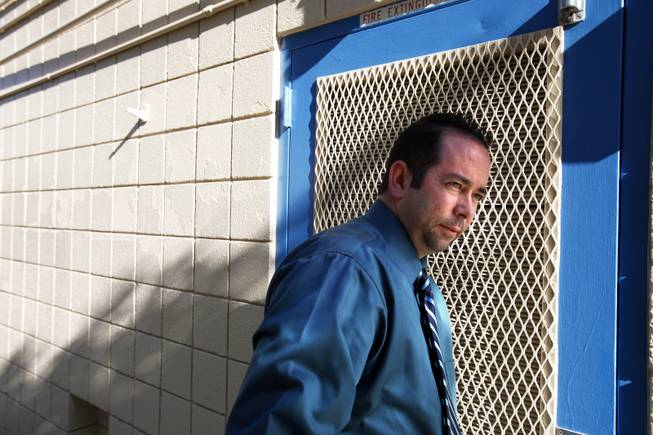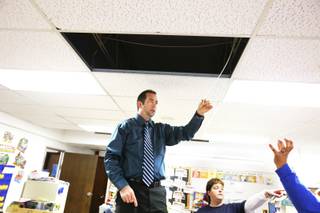
Principal Tim Adams of Rex Bell Elementary School stands on the school grounds in Las Vegas Wednesday, Dec. 14, 2011.
Monday, Dec. 19, 2011 | 2 a.m.
Sun coverage
Amid the worst recession in more than 50 years, the Clark County School District estimates it will need $5.1 billion (with a "b") to repair and modernize its school buildings over the next 10 years — work that was put off because there wasn’t money to do it.
More than $3 billion is needed to fix dilapidated schools. Nine new elementary schools need to be built to alleviate overcrowded classrooms. And the district wants to invest nearly $1 billion in technology and equipment to prepare children for their digital future.
The cash-strapped district is contemplating seeking voter approval to issue bonds to pay for the capital improvements but wouldn’t be in a position to sell those bonds for five years, said Chief Financial Officer Jeff Weiler.
And in the meantime, Weiler noted, schools continue to deteriorate.
Paint is peeling, ceiling tiles are falling and air conditioning units are failing at some of the district’s oldest schools. Faced with multimillion budget shortfalls, the district slashed its funding for school maintenance over the past several years, delaying necessary repairs to school facilities.
Putting off maintenance might save costs in the short term, but may lead to bigger and costlier problems later — not unlike putting off a routine oil change for a car only to have to buy a new transmission down the road, said Paul Gerner, the district’s associate superintendent of facilities.
“It’s a death spiral,” Gerner said, lamenting the budget cuts that have forced the district to defer repairs. “We’re fighting a losing battle.”
•••
In 1998, the district – now the nation’s fifth largest – instituted a voter-approved bond program that generated $4.9 billion to help cover the cost of its unprecedented growth.
Most of the money was used to build 120 new and replacement schools; about a third went toward renovating 229 schools. It was a successful capital plan that constructed and rehabilitated more schools than it promised, Weiler said.
The last schools built with the bond opened in fall 2010. The district is using about $100 million in leftover funds for high-priority renovations.
But that’s not nearly enough to maintain all 357 schools and 35 administrative buildings, Gerner said. The district needs at least $200 million each year for maintenance – more likely upwards of $260 million annually if repairs continue to be deferred, he said.
Even with the 1998 bond, facility maintenance was “grossly underfunded,” Gerner said.
The School District on average spends less on maintenance than many of its peer districts. In 2008, the Broward County Public Schools in Florida – the nation’s sixth largest – outspent its larger counterpart in Nevada, $2.68 per square foot to $1.52 per square foot.
Moreover, as the economic downturn took its toll on the district, it cut 25 percent of the staff in the facilities department.
“We’re spread so thin, we’re just putting out fires,” said Randy Shingleton, a director in the district’s maintenance department charged with overseeing work orders. “We’re really taxing our guys to do more with less.”
Work orders became backlogged. A leaking roof took months to repair. Classroom heating issues took days to resolve.
Fixing immediate problems means less time spent making the repairs necessary to prevent bigger problems, Shingleton said.
A recent report by an outside consulting group — paid through private funds — found that many schools were forgoing repairs that could prevent major problems in the long run.
A model school system should spend nearly two thirds of its maintenance resources toward preventative measures, with the rest going toward corrective maintenance, Shingleton said. But in the Clark County School District, only about 11 percent went toward preventative maintenance.
It’s like skipping regular dental checkups and only seeing a dentist when there are cavities.
To sift through the large number of repair requests, the district implemented a triage system akin to disaster relief efforts, Shingleton said. The facilities department began prioritizing work orders based on the severity of the problem and how many students it affected.
Schools were also prioritized using a nationally recognized metric called the Facility Condition Index. It’s basically the ratio of the repair cost to the overall value of a building. The higher the repair cost, the greater the incentive to replace and rebuild.
The average Clark County school is 22 years old, with needed repairs costing about 11.5 percent of its value.
Gerner has identified 20 schools where the cost of repairs total more than 20 percent of the schools’ value.
“We’re going to continue to be as responsive and as responsible as we can,” Gerner said. “But I sure as hell wish I had more money.”
•••
The confluence of budget cuts and the draining of the 1998 bond money, which funded maintenance up to this point, has created a “perfect storm” scenario for the district, Gerner says.
To fund necessary school repairs, the School District must get more state money or rely on another capital bond program. Both remain elusive as property tax revenues continue to decline with Southern Nevada’s depressed housing market.
For the School District to issue a bond, its revenues – mainly from property taxes – must exceed the debt on its previous bond measures, which are still being repaid . The district does not expect to have the bonding capacity for another five years – until 2017 – which may come too late for some of the district’s oldest and most dilapidated schools.
The 58-year-old J.D. Smith Middle School in North Las Vegas is the oldest middle school in the valley. Cost of repairs there are estimated at about a third of the building’s monetary value.
At Smith, rainwater seeps up from clogged storm drains and trickles down into classrooms from leaky rooftops. The school can’t regulate its temperature – there’s only hot or cold, no thermostat. Doors jam because the ground has shifted over the decades.
The worst problem? The air conditioner breaks down on a regular basis, prompting school administrators to hand out Popsicles to students.
“When it’s hot, it takes a lot out of us,” Principal Christine Ahrens said, adding she feels the district has been responsive to her school’s needs. “The kids are remarkably resilient. We just go on.”
In five years however – right when the School District might be able to start issuing bonds to fund repairs – Smith’s cost of repairs is expected to climb to a record 94 percent of the school’s value. By that time, the school might have to close because there are simply too many problems.
•••
Some schools have gotten creative as they sit in repair-limbo.
At Rex Bell Elementary School in the central valley, Principal Tim Adams sought private grants and enlisted the help of Eagle Scout candidates to repaint portions of the school and erect a flag pole. The 47-year-old school was due for major renovations last year, but because of the economy, Adams was left twiddling thumbs.
Meanwhile, enrollment has swelled at Bell. As families lost their homes in the recession, they have moved back into the neighborhood, which is characterized by apartment complexes and budget suites, Adams said.
Bell was built for a maximum of 400 students, back when Las Vegas was a much smaller city. Now, the school is bursting at the seams, holding double that number of students in its classrooms and in 16 portable buildings.
Facilities problems are felt more acutely at overcrowded schools, Adams said. When a roof leaks or an air conditioning unit goes kaput, students are shuffled around to other classrooms where they don’t have a desk or they’re sitting on the floor, he said
More students taxes the electric grid as well, Adams added. The school wasn’t built for the digital age of smartboards, projectors and microphone systems in every classroom, and circuit breakers pop regularly, he said.
“It’s very disconcerting,” said School Board member Lorraine Alderman, who represents Smith and Rex Bell. “We can’t allow our schools to fall apart and be unsafe for kids. That’s just not negotiable.”
[email protected] / 948-7828 / @paul_takahashi


Join the Discussion:
Check this out for a full explanation of our conversion to the LiveFyre commenting system and instructions on how to sign up for an account.
Full comments policy